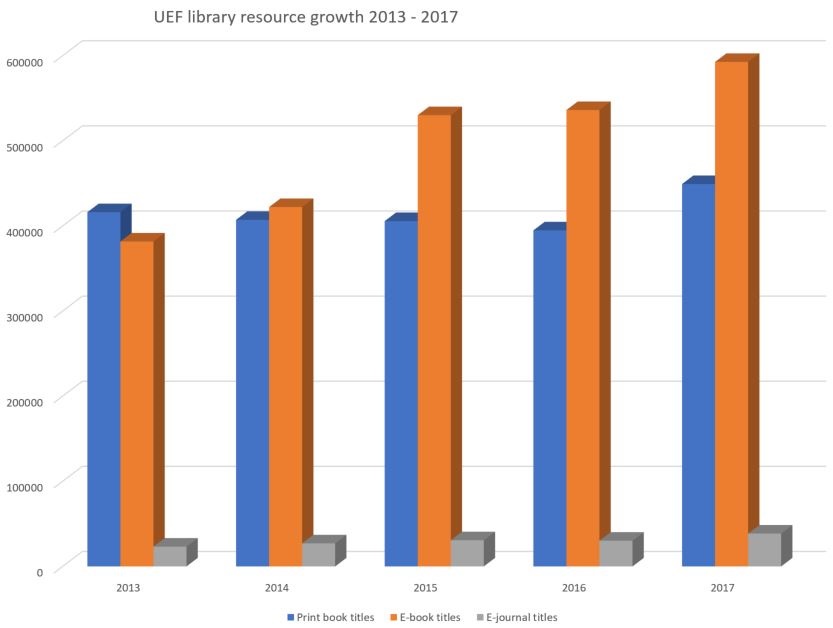Tehokas kirjasto — toiminnan kehitys tilastojen valossa | Effective library — development based on the statistics
(Please, scroll down to read in English.)
Vuoden 2017 kirjastotilastot ovat valmistuneet ja niitä voi käydä tutkailemassa Tieteellisten kirjastojen tilastotietokannassa. Tässä tarkastelen kirjaston toiminnan kehittymistä viiden viime vuoden (2013 – 2017) aikana.
Kirjaston painettujen kirjojen lukumäärä on tasaantunut tuona kautena noin 700 000 kappaleeseen. Digitaalisten kirjojen määrä on puolestaan jatkanut kasvuaan vuoden 2013 noin 400 000 nimekkkeestä viime vuoden noin 600 000 nimekkeeseen. Näiden yhteenlaskettu nimekemäärä ylittää jo miljoonan.
Painettujen kirjojen vuotuinen lainaus on laskenut hitaasti noin 170 000 lainasta 140 000 lainaan. Sen sijaan e-kirjojen käytön määrä on kaksinkertaistunut tarkkailtuna viisivuotiskautena. Noin 900 000 katsotusta dokumentista on päädytty reiluun kahteen miljoonaan. Muidenkin digitaalisten aineistojen käyttöluvut ovat säilyneet suurina ollen miljoonaluokkaa. Lukumääräisesti suurin tietoaineistojen käyttö on siirtynyt lopullisesti digitaaliseen ympäristöön, kun e-kirjojen käyttöluvut ovat kasvaneet merkittävästi tänä kautena.
Kirjaston antama tiedonhaun opetus on ollut myös hienoisessa kasvussa ja siinäkin on siirrytty verkko-opetukseen. Kirjaston asiakastilojen kehittäminen näkyy sekä aukioloaikojen pidentymisenä että luku- ja työskentelypaikkojen lisääntymisenä.
Kirjaston toimintakulut ovat pysyneet käytännössä samana tänä aikana. Koska kulut ovat kuitenkin koko ajan kasvaneet, ovat tehostamistoimet vaikuttaneet niin, että kirjaston henkilöstän määrä on vähentynyt viisivuotiskaudella noin 15 henkilötyövuodella. Käytännössä vapautuva resurssi on käytetty aineistoihin, joiden hinnannousu on ollut noin 100 000 euroa vuodessa.
Kirjastomme onkin hyvin tehokas. Digitaalisen aineiston lataushinta on pienentynyt koko ajan (viime vuonna €1,26) ja kokonaiskulut suhteutettuna yliopistolaisiin olivat viime vuonna noin 400 euroa. Tällä yliopiston panostuksella kukin yliopistolainen saa edellä kuvatut kirjastoaineistot ja palvelut käyttöönsä.

Library statistics for the year 2017 have been completed and can be accessed by visiting The Research Library Statistics Database. In the following, I will review the development of the library during the last five years (2013 – 2017).
The number of print books in the library has been stabilized during that period to 700,000 copies. The number of digital books, on the other hand, has continued to grow from about 400,000 titles to some 600,000 titles in the year 2017. Their total number exceeds already a million titles.
The borrowing of print books has slowed down from about 170,000 loans to 140,000 loans. At the same time, the use of e-books has been doubled in numbers: from approximately 900,000 downloads to over two millions. The usage of other digital records has also remained high, the size being in one million downloads in each category. Thus, one can say that the major use of the documents has shifted to the digital environment, especially when the use of the e-books has grown significantly during this period.
The information skills training provided by the library has also increased a bit and it has also moved to eLearning. The development of the library’s premises is reflected both in prolonging the opening hours and in increasing the number of reading and working places.
The library’s operating costs have remained virtually the same during this period. However, as costs have increased all the time, the efficiency required from the library has meant a reduction in the number of staff in the library by about 15 person-years. In practice, the resource released has been used for the library collection, the price increase of which is around 100,000 euros per year.
Our library is very effective. The download price of digital material has been decreasing (last year € 1.26) and the total cost divided to each member of the university staff and students was about 400 euros. With this University’s contribution, each member of the academia gets the library resources and services described above.
Jarmo Saarti, kirjaston johtaja | Library director